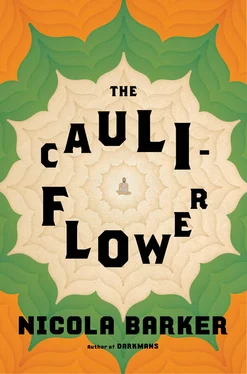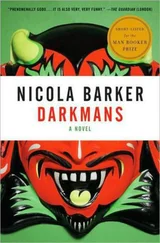Ah, there you go … we’re now actually inside one of the— oops —an irate temple guard is running around trying to hit the swift with a giant fan.… He’d certainly better— ouch —the tiny camera just got a bit of a thwack and then the swift flew straight into the— oooh —that isn’t … that wasn’t— go-aan , me lad! Another quick … yup … and we’re out!
Phew! Although the camera is slightly wonky now … uh … just tip your head to one side if you will … yes … the circa-1855 swift is heading at pretty much full pelt (if you press the green button on your remote you’ll see a small reading of his current speed) toward the dramatically flowering oleander which stands close to the water’s edge, and just beyond it, the two huge and quite magnificent palms.
He’s just … he’s gradually … there’s quite a bit of wind from the river at this altitude, and it seems to be making the slightly damaged camera vibrate pretty rapidly … wooooah-woooah-woooah-woooah .… I’m going to turn the volume down completely because I’m finding that noise strangely disturbing. It’s something of a teeth rattler.
In truth, I rather regret not fastening the camera (which has actually taken up over 76 percent of this book’s total budget) to something a little more sedentary — a sparrow, perhaps, or a cat … although— woooop! Here we go — we’re back inside the main courtyard … to your left is the large, flat-roofed, many-arched white and red Radhakanta Temple, which contains images of Krishna and Radha (the great lovers). If you get a chance to peer through the — no, we’ve moved on. The floors (I’m reliably informed) are marble, and there are chandeliers covered in sackcloth to prevent—
Now that’s the Nat Mandir or theater hall.… It’s on the other side of the … the Kali Temple compound and it … it echoes the Radhakanta temple architecturally with all of the … you know … the grand flourishes: a series of majestic pillars supporting a flat roof, the smart white-and-red finish.… But if you just — Quick! While you have the chance: In the far right-hand corner of the screen you can see the magnificent wedding-cake form of the nine-spired Kali Temple, which stands on its high platform, accessible via a grand flight of stairs. It’s in the — you probably can’t see from this angle; we’re suddenly flying up rather close — but it’s in the traditional Bengal style and rises to a height of over thirty meters.…
Oh. We’ve nipped around the back. Up ahead is the big tank (or reservoir) with its plate-washing ghat ; this is basically the business end of the structure. If we’d had a chance to get a better … if we’d … because the courtyard of the Kali Temple is fenced in on three sides by a neatly balconied rectangular wall of offices and kitchens and guest rooms and temple stores.… In fact … just to the right of this vast tank you can get a fleeting glimpse at a big pile of construction materials. The Rani started building in 1847, so it’s taken her almost eight years thus far and there’s still plenty to …
Oh. These are the orchards. This really is a prodigious plot — almost twenty acres, in total, and it was originally the site of an ancient, but long abandoned, Moslem cemetery. In fact if we could … if we could just fly a little higher for a moment (we can’t — we aren’t — forgive my mordant laugh/groan) you’d see that the whole thing is in the shape of a giant tortoise shell (lower on the edges, higher at the center), which is considered highly auspicious to the …
Another orchard. Everything newly planted and incredibly lush. To the right (or the east) are the imposing main entrance gates, although we probably won’t get a chance to — to the left … ah … the kuthi —can you…? No. Well, it’s the beautiful mansion the Rani had built for when she and her family are in residence. It will mainly be used to house important guests and host lavish events. Although for many years Sri Ramakrishna himself will inhabit a big room on the ground floor to the western corner of …
Two more tanks … yes … One is the goose tank.… We’re heading north — no, south — you’ll see the tiny compass rotating crazily at the base of the screen.… I’m not sure if … oh! Yes. And this is actually quite a significant area in the Ramakrishna story — that’s … to the top left … that’s the ancient bael tree (or vilwa ) in the densely forested area, or “wilderness,” at the northern boundary of the compound, where Ramakrishna first removed his sacred thread (much to his poor nephew Hriday’s abundant horror) while meditating, alone, at night, and where, if you look — sharp right! Very quickly — you will see the Government Magazine just beyond the boundary, with its affable Sikh guards whom Ramakrishna became very friendly with during the course of — and the …
Oh — oh no. Oh dear. Please, ladies, gentlemen, avert your eyes. We’ve jinked into the pine grove which is used principally for defecation. That’s — oh dear … oh no … uh … oh goodness gracious me, that’s just … There are a fair number of little insects in the vicinity, and so the circa-1855 swift is rather drawn to — uh …
Ah! We’re now rapidly approaching an area where — in the not-too-distant future — Ramakrishna will experience some of the most important moments in his sadhana (or spiritual journey). Peel your eyes! To the left! Quick! Quick! That’s the site of Ramakrishna’s small, thatched meditation hut, and just beyond it he will (in 1868, after a pilgrimage to Vrindavan) plant his famous panchavati . He will collect some dust in that most holy city — the site of the ancient forest where Krishna spent his happiest childhood days — and scatter it here, in this spot. The word panchavati refers to the forest home of Rama (seventh avatar of Vishnu), but in plain English, it is a small grove of five trees — the banyan , the peepul , the amalaka , the asoka , and the bael —and is considered to be a perfect, peaceful, shady venue for spiritual pursuits.
Oh. To the right. That’s the other ghat … the second ghat , the Bakul Tala Ghat, which is very close to Ramakrishna’s corner kuthi room, and also close to the northern nahabat , or music tower (there are two, one situated on the northern and the other on the southern side of the main courtyard; they play holy music there during various phases of the day’s worship). Ramakrishna’s mother, Chandradevi, and then later on his wife, Sarada Devi (aka the Holy Mother — yes, he did marry, and the union was blissful but unconsummated), would live for many years (in considerable discomfort, I imagine) in the tiny storeroom at the base of the northern nahabat .
Um … There seems to be something … I don’t really like to mention it, but you may have noticed a certain amount of, of breakup in the visual transmission…? Some kind of dark … black … a shadow, almost, in the top right-hand corner of the…? I’m just hoping against hope that if we continue moving forward for a couple more seconds we may actually get to fly past the small room just beyond the northern nahabat , which is situated at the end of the northern wall of kitchens/stores/offices et cetera, with its wonderful southeastern verandah looking directly into the main temple compound, and its other northeastern one with views of the gardens, the kuthi and the nahabat , not to mention its grand semicircular porch to the fore which looks straight across the holy Ganga.… This was to be Sri Ramakrishna’s second main residence during his long stay at Dakshineswar. It’s now open to the public in its original state, virtually untouched — although they upgraded the floors, which is a great shame — and a site of pilgrimage for many thousands — nay, millions — of loyal devotees from all across the …
Читать дальше












